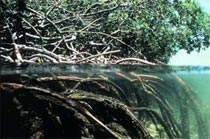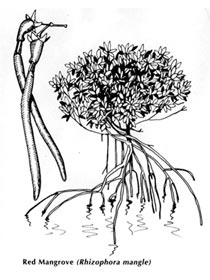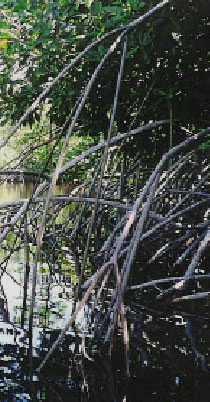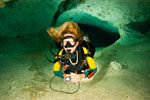The Mangroves

(the intertidal zone) because they have developed a set of physiological adaptations to overcome the problems of anoxia, salinity and frequent inundation. Each species has its own capabilities and solutions to these problems and this is perhaps the primary reason why on some shorelines mangrove tree species show distinct zonation as a consequence of variations in the range of environmental conditions across the intertidal zone.
The mix of species at any location within the intertidal zone is therefore partly determined by the tolerances of individual species to physical conditions such as tidal inundation and salinity, but also may be influenced by other factors such as predation of their seedlings by crabs. Once established, the roots of the mangrove plants help to impede water flow and thereby enhance the deposition of sediment in areas where it is already occurring. It is usually the case that the fine, anoxic sediments under mangroves act as sinks for a variety of heavy (trace) metals which are scavenged from the overlying seawater by colloidal particles in the sediments. In areas of the world where mangroves have been removed for development purposes, the disturbance of these underlying sediments often creates problems of trace metal contamination of sea water and biota.
It is often stated that mangroves provide significant value in the coastal zone as a buffer against erosion, storm surge and tsunamis. While there is some attenuation of wave heights and energy as seawater passes through mangrove stands, it must be recognized that these trees typically inhabit areas of coastline where low wave energies are the norm. Therefore their capacity to ameliorate high energy events like storm surge and tsunamis is limited. Their long term impact on rates of erosion is also likely to be limited. Many river channels that wind through mangrove areas are actively eroding stands of mangroves on the outer sides of all the river bends, just as new stands of mangroves are appearing on the inner sides of these same bends where sediment is accreting.
What are Mangroves?
Mangroves are one of Mexico's true coastal natives. They thrive in salty environments because they are able to obtain fresh water from saltwater. Some secrete excess salt through their leaves; others block absorption of salt at their roots.
through their leaves; others block absorption of salt at their roots.
The Riviera Maya has thousands of acres of mangrove forests contribute to the overall health of the state's coastal zone and one of the world’s last living coral reefs, the Mesoamerican Reef. This ecosystem traps and cycles various organic materials, chemical elements, and important nutrients. Mangrove roots act not only as physical traps but provide attachment surfaces for various marine organisms. Many of these attached organisms filter water through their bodies and, in turn, trap and cycle nutrients. The relationship between mangroves and their associated marine life cannot be overemphasized. Mangroves provide protected nursery areas for fishes, crustaceans, and shellfish. They also provide food for a multitude of marine species such as snook, snapper,tarpon, jack, sheepshead, red drum, oyster, shrimp and lobsters. Mexico’s important recreational and commercial fisheries will drastically decline without healthy mangrove forests acting as a filter and a nursery.
Many animals find shelter either in the roots or branches of mangroves.Mangrove branches are rookeries, or nesting areas, for beautiful coastal birds such as pelicans and spoonbills. Worldwide, more than 50 species of mangroves exist. Of the three species found in Mexico, the red mangrove, Rhizophora mangle, is probably the most well-known. It typically grows along the water's edge. The red mangrove is easily identified by its tangled, reddish roots called "prop roots."These roots have earned mangroves the title, "walking trees." The mangrove appears to be standing or walking on the surface of the water.
The black mangrove, Avicennia germinans,can be identified by numerous finger-like projections called pneumatophores that protrude from the soil or water around the tree's trunk. These black straw shaped plants actually clean our air for us as they are absorbers of Carbon Dioxide. The white mangrove, Laguncularia racemosa, usually occupies the highest elevations further upland than either the red or black mangroves.Unlike its red or black counterparts, the white mangrove has no visible aerial root systems. The easiest way to identify the white mangrove is by the leaves.They are elliptical, light yellow green and have two distinguishing glands at the base of the leaf blade where the stem starts.
All three of these species utilize a remarkable method of propagation. Seeds sprout while still on the trees and drop into the soft bottom around the base of the trees or are transported by currents and tides to other suitable locations. The Yucatan’s coastal mangroves are tropical species; therefore,they are sensitive to extreme temperature fluctuations as well as subfreezing temperatures. Research indicates that salinity, water temperature, tidal fluctuations, and soil also affect their growth and distribution. All three species grow intermixed.

The people that live along coasts benefit in many ways from mangrove forests.Mangrove forests protect uplands from storm winds, waves, and floods. The amount of protection afforded by mangroves depends upon the width of the forest. A very narrow fringe of mangroves offers limited protection, while a wide fringe can considerably reduce wave and flood damage to landward areas by enabling overflowing water to be absorbed into the expanse of forest. Mangroves can also help prevent erosion and sand loss by stabilizing shorelines with their specialized root systems. Mangroves also filter water and maintain water quality and clarity.
Mangrove losses in Mexico
It is true that mangroves can be naturally damaged and destroyed, but there is no doubt that human impact has been most severe. With the construction of new hotel chains lining the Mexican Caribbean’s coastline, including Cancun, south to Puerto Morelos, Playa Del Carmen, Puerto Aventuras, Akumal, to the ruins of Tulum, south to the Biosphere, and then on down to Chetumal, which runs through the new extensive development of the Costa Maya, has caused overwhelming mangrove loss. While we fill in the mangrove waters to make way for hotels,malls, restaurants, and other beach front constructions, what are we damaging?
For our own safety and happiness, the local environment and the planet should not be damaged irresponsibly. The laws that protect the environment need to be followed and enforced. We are not alone, but rather share our habitat with all natural creatures. So let us help to save mangroves and related ecosystems like coral reefs, beaches, cenotes, coastal jungles, wetlands and rivers.Development is happening, but we should not destroy our house, while trying to improve it. Remember that without the ecosystems, the life cycle of species is impossible,including humans. It is up to us to ensure a place in our future for our valuable mangroves and coastal resources. By saving them, we will be saving ourselves too.



